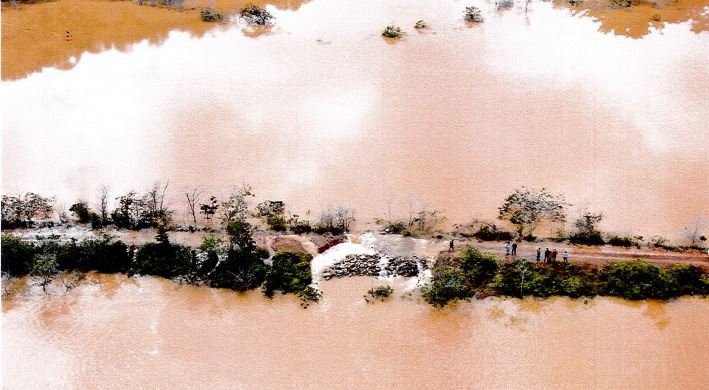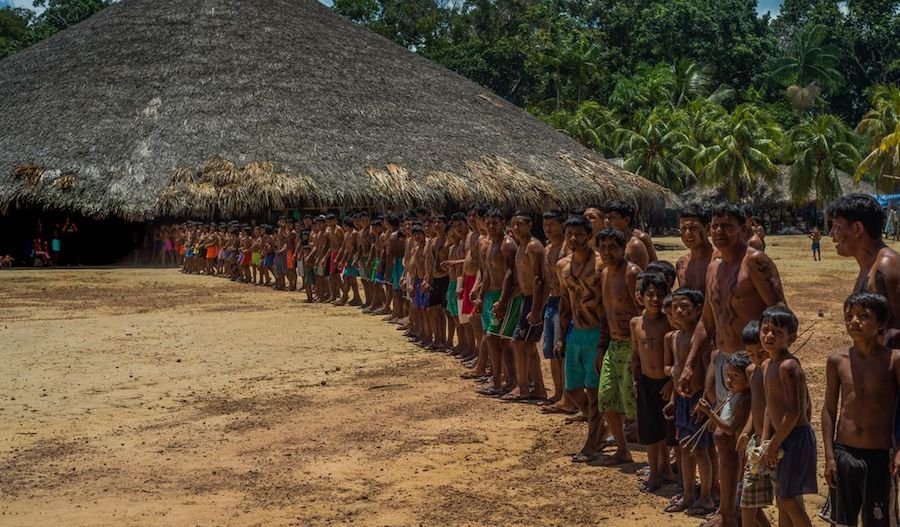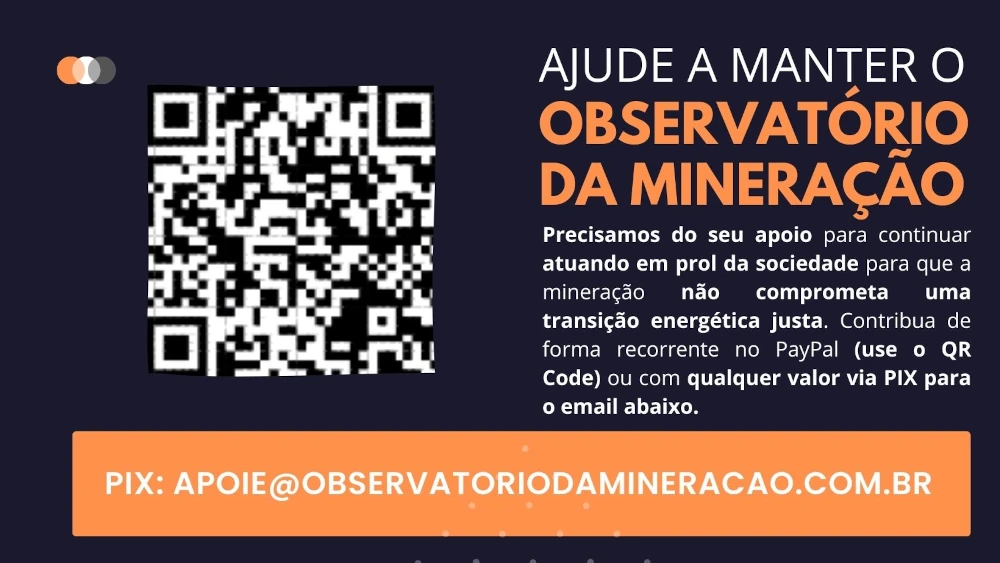A leak of tailings dams from the mining company Taboca, owned by the peruvian group Minsur, which operates in Presidente Figueiredo (AM), 300km from Amazonas capital Manaus, reached rivers within the Waimiri-Atroari indigenous land that are essential for the life of the population.
The contamination was identified by the indigenous people and confirmed in two expeditions with the participation of the National Indian Foundation (Funai) and the mining company’s own environmental coordinator.
Following the trace of the tailings, the team arrived at the Taboca facilities and verified that dams inside the mining company are leaking, with on-site verification and photos taken by drones.
The report by the Funai Waimiri-Atroari Ethno-Environmental Protection Front shows that contamination has already altered the water quality of the Tiaraju and Alalaú rivers, where the indigenous people fish and use the water for consumption, hygiene and food preparation.
22 villages were affected. Taboca is the largest tin producer in Brazil and has an immense mining project alongside the indigenous land.

The area occupied by the mining company, however, is traditionally occupied by the Waimiri-Atroari and ended up being excluded from the demarcation process in the 1980s, already under pressure from the mining company.
The Federal Prosecutor’s Office of Amazonas asked for an immediate suspension of the release of any waste in Taboca dams in Amazonas and the adoption of urgent repair measures. The leaks were identified in 6 structures in total.
The death of fish and turtles for no apparent reason has been identified in the region. The water is cloudy and dense and has an unpleasant smell.
Taboca Mining denied that the dams are leaking and that the rivers were contaminated by the mining company’s responsibility. According to Taboca, the change in water quality is due exclusively to the excessive rainfall recorded in the region.
That is not what the report says. Harilson Araújo, a lawyer for 14 years at Associação Waimiri-Atroari, also questions the claim.
“If the rain contributed, there was negligence in not taking measures to foresee this amount of water. The leakage problem exists and has been proven. Nothing was done until they were notified. You can’t blame the rain. At the very least, they sinned by omission”, says Araújo.

According to the lawyer, the indigenous people stopped consuming fish, hunting and using water for fear of contamination. Children became ill and were taken to medical care. The fear of the indigenous population is about the extent of the problem and how long it can take for everything to be resolved.
“From the experience we have, the solution will not be as fast as many people think. The consequences for the future can last. There are 22 villages that depend directly on water for their livelihood, their way of life, culture. The river is their life. It is a very strong aggression. The indigenous people are extremely concerned”, reports Araújo.
Main dam of Taboca is 4 times bigger than Brumadinho Vale dam
National Mining Agency (ANM) lists 15 Taboca dams and structures in Presidente Figueiredo, 8 in operation and 7 deactivated, which are not even included in the official data.
The main one in operation is the 158 (A-1) dam, with 53.3 million cubic meters of tailings, which does not have a waterproofing mat. This dam is 4 times larger than the Vale dam that broke in Brumadinho.
The prosecutors asks Taboca to take immediate measures to contain the dams and guarantee the supply of drinking water and complementary food to the indigenous people in the villages affected by the problem.
Portuguese: Rejeitos da mineradora Taboca, do grupo peruano Minsur, contaminam rios do povo Waimiri-Atroari no Amazonas
ANM says that the last survey on dam 158 was carried out on April 27. This dam has an Emergency Action Plan (PAE), which was provided to municipal and state municipal governments and civil defenses, as required by law. Its “Potential Damage” is considered high, with significant environmental impact in protected areas.
The prosecutors questions why Mineração Taboca did not take the necessary measures, triggered the Emergency Plan and the competent authorities even in March, when the contamination was identified. All surveys carried out in May show the worsening of the situation.
According to Harilson Araújo, after two meetings, including moments of tension and denial, Taboca changed its discourse and pledged to carry out emergency measures such as the drilling of solar powered artesian wells and the supply of clay filters and animals for food of indigenous people.
Internally, he says, the competent bodies are demanding that Taboca take the necessary measures to resolve the leaks.

The fear that a Taboca dam will break is real, says Araújo, who recently spoke with leaders after the contamination was identified.
In a note, Taboca says that “the dams are stable and safe, as attested in technical reports already submitted to the Institute of Environmental Protection of Amazonas (IPAAM) and MPF-AM in the last week”.
The mining company again said that “there is no overflow in any of the Taboca Mining dams”. According to the company, regular inspection and monitoring activities are being carried out.
“We are also, as preventive measures, building filtering dikes and dissipating channels designed to expand the filtration of suspended materials and reduce water turbidity in the area, which remains under monitoring 24 hours a day,” said Taboca, in a note.
Harilson Araújo, of the Waimiri-Atroari Association, says that the indigenous people are constantly concerned about the risk of some major environmental disaster due to the tailings dams, as in Mariana and Brumadinho.
“The fear is enormous. Taboca has a very large set of dams. Even those that are disabled, if there is no maintenance, what happened in Mariana and Brumadinho can happen. If you break such a dam and reach the Alalaú River, which is the river of life for these indians, it will be a huge disaster”, says Araújo.
More than 2,000 indigenous people live in the territory, which were almost completely wiped out during the Brazilian military dictatorship.
In addition to emergency actions, a work plan is being defined to try to solve the problem permanently. Only ongoing analyzes by the Amazonas Environmental Protection Institute (Ipaam) will be able to give the exact dimension of the identified contamination.
On Mongabay: World’s richest tin mine pollutes rivers serving Amazon Indigenous villages

99 mining requests target Waimiri-Atroari. 37 of the Minsur Group.
Data from the National Mining Agency (ANM) consulted by the report show that, today, TI Waimiri-Atroari has 99 pending mining requests, almost all for research, mainly from the 1980s, followed by the 1990s.
Mamoré Mineração e Metalurgia, which belongs to Taboca and Taboca itself lead with 37 research and mining requirements dating from the 1980s, with only one in 1978 and another in 2004, to explore zircon, cassiterite and tin.
All, however, had updates in 2019. The approval of PL 191/2020 by Jair Bolsonaro, which releases mining on indigenous lands, is considered a priority by the president of Congress, Arthur Lira.
In a note, Taboca denied interest. “Our performance is based on principles of social and environmental responsibility and we have greater respect for our neighbors, so we do not operate, nor will we operate on indigenous lands,” said Taboca.

Tin from Amazonas is smelted in São Paulo and has China as main destination
Taboca presents itself as “the largest tin producer refined in Brazil” and claims to be “transparent and committed to the environment”. In 2020, Taboca, which also explores niobium and tantalum, had revenues of R$ 753 million.
Founded in 1969, Taboca owns the Pitinga Mine, which started operating in the 1980s and has an estimated useful life for tin production of 100 years. The tin extracted in Amazonas is melted in a metallurgy in São Paulo.
Created by the Brazilian group Paranapanema, Taboca was acquired by the Peruvian group Minsur in 2008, a business of R$ 850 million. Minsur is one of the main producers of tin in the world, a mineral that is consumed mainly by China, with about 50% of the total.
Minsur’s main investor is the Profuturo AFP investment fund, which is owned by Scotiabank, a multinational bank in Canada.
Descubra mais sobre Observatório da Mineração
Assine para receber nossas notícias mais recentes por e-mail.





